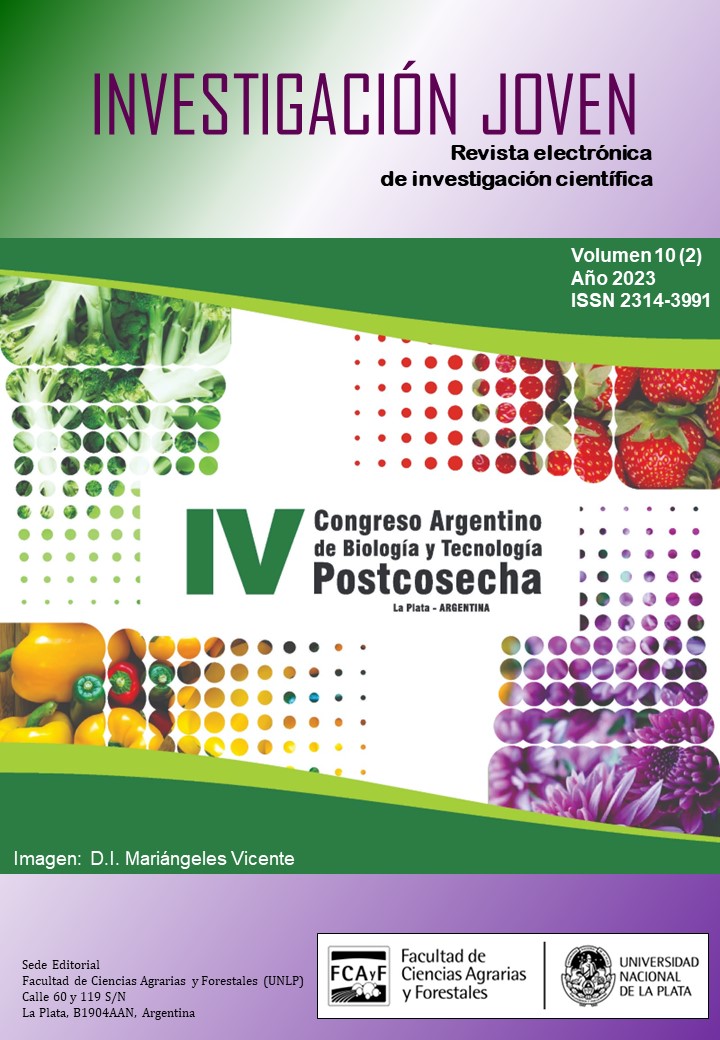Quality of Jerusalem artichoke as affected by conservation method
Keywords:
Helianthus tuberosus L., tuber, postharvest, conservation, inulinAbstract
A conservation study was carried out with Jerusalem artichoke tubers (Helianthus tuberosus L.) with white skin and two phenotypes: elongated (A) and round (R). They were harvested, conditioned and stored in polyethylene bags at two refrigeration temperatures: 0°C (C) and 7°C (H). They were compared with 3 assays of tubers without conditioning, at ambient temperature: in bags and protected from light (E), in sand (S) and in the field without harvesting (T). Weight loss, sprouting, and fungal development were recorded weekly. Soluble solids, dry matter, color of epidermis and pulp, firmness of the pulp, pH, acidity and inulin content were determined monthly. The greatest weight loss was recorded under S (30.36% R and 20.60% A), with only one month of duration, while C allowed to extend the shelf life up to 12 months, observing very little dehydration (∆P≈2%) for both phenotypes, and a significant decrease in inulin content only in R (p<0.05). C assay conservation allowed the postharvest life of both phenotypes to be prolonged without sprouting or significant dehydration, maintaining acceptable nutritional quality, making it possible the availability of the tuber to be consumed over the course of a year.
Downloads
References
R. Amarowicz, B. Cwalina-Ambroziak, M. Janiak, B. Bogucka. “Effect of N Fertilization on the Content of Phenolic Compounds in Jerusalem Artichoke (Helianthus tuberosus L.) Tubers and Their Antioxidant Capacity”. Agronomy 10, 2020, 1215-1227.
L. Ibarguren, C. Rebora. “El cultivo de topinambur: generalidades sobre su ecofisiología y manejo”. Horticultura Argentina 32, 2013, 35-41.
A. Ribeiro, M. da Silva, B. Tagliapietra, B. Brum Junior, M. Ugalde, N. Richards. “Development of symbiotic yoghurt and biological evaluation (New Zealand White Rabbits) of its functional properties”. Food. Sci. 39, 2019, 418-425.
V. Bach, M. Clausen, M. Edelenbos. “Production of Jerusalem Artichoke (Helianthus tuberosus L.) and Impact on Inulin and Phenolic Compounds”. En Processing and Impacton Active Components in Food. V. Preedy. Ed. London: Academic Press, 2015, 97-102.
L. Catană, M. Catană, E. Iorga, A. Lazăr, M. Lazăr, R. Teodorescu, A. Asănică, N. Belc, A. Iancu. “Valorification of jerusalem artichoke tubers (Helianthus tuberosus) for achieving of functional ingredient with high nutritional value”. Agriculture for life 1, 2018, 276-283.
G. Sharma, W. Wu, E. Dalal. “The CIEDE2000 colour-difference formula: Implementation Notes, Supplementary Test Data, and Mathematical Observations”. Color Res Appl 30, 2005, 21-30.
Association of Official Analytical Chemists (AOAC). Official Methods of Analysis, Fifteenth Edition. Virginia, USA: Aoac Intl, 1990.
A. Zuleta, M. Sambucetti. “Inulin determination for food labeling”. J. Agric. Food Chem. 49, 2001, 4570-4572.
V. Singleton, y J. Rossi. “Colorimetry of total phenolics with phosphomolybdic-phosphotungstic acid reagents”. Am J Enol Vitic. 16, 1965, 144–158.
J. Zhishen, T. Mengcheng y W. Jianming. “The determination of flavonoid contents in mulberry and their scavenging effects on superoxide radicals”. Food Chem. 64, 1999, 555-559.
A. Sozzi, M. Zambon, G. Mazza y D. Salvatori. “Fluidized bed drying of blackberry wastes: Drying kinetics, particle characterization and nutritional value of the obtained granular solids”. Powder Technol. 385, 2021, 37-49
I. Benzie y J. Strain.” Ferric reducing ability of plasma (FRAP) as a measure of antioxidant power: The FRAP assay”. Anal Biochem. 239, 1996, 70-76.
J. Di Rienzo, F. Casanoves, M. Balzarini, L. Gonzalez, M. Tablada, C. Robledo. InfoStat versión 2020 [online]. Argentina: Universidad Nacional de Córdoba, 2020. Disponible en: http://www.infostat.com.ar Visitado en agosto de 2023.
H. Danilčenko, E. Jarienė, P. Aleknavičienė, M. Gajewski. “Quality of Jerusalem Artichoke (Helianthus tuberosus L.) Tubers in Relation to Storage Conditions”. Not. Bot. Hort. Agrobot. Cluj 36, 2008, 23-27
P. Konvalinková. "Generative and vegetative reproduction of Helianthus tuberosus, an invasive plant in central Europe". En Plant Invasions: Ecological Threats and Management Solutions, L. Child, Ed. Backhuys Publishers: Netherlands, 2003, 289-299.
L.E. Rodríguez, L.P. Moreno. “Factores y mecanismos relacionados con la dormancia en tubérculos de papa. Una revisión”. Agronomía Colombiana 28, 2010, 189-197.
A. Obregón, R. Repo. “Evaluación fisicoquímica y bromatológica de cuatro variedades nativas de papa (Solanum SPP.)”. Ciencia e Investigación 16, 2013, 38-40.
L. Ibarguren. “Efecto del momento de cosecha sobre la calidad hortícola del topinambur (Helianthus tuberosus L.) conservado en cámara frigorífica”. Tesis de maestría, Facultad de Ciencias Agrarias, Universidad Nacional de Cuyo, Mendoza, 2015.
W.T. Saengthobpinit, T. Sajjaanantakul. “Influence of harvest time and storage temperature on charecteristics of inulin from Jerusalem artichoke (Helianthus tuberosus L.) tubers”. Postharvest Biol. Technol. 37, 2005, 93-100.
L. Franceschinis, P. Sette, D. Salvatori, C. Schebor. “Valorization of postharvest sweet cherry discard for the development of dehydrated fruit ingredients: compositional, physical, and mechanical properties”. J. Sci. Food Agric. 98, 2018, 5450–5458.
Instituto Universitario de Nutrición y Tecnología de los Alimentos (INTA), Base de Datos de Actividad Antioxidante (ORAC) y de Contenido de Polifenoles Totales (PFT) en Hortalizas. [online]. Chile: Universidad de Chile, 2004 Disponible en: https://portalantioxidantes.com/base-de-datos-de-actividad-antioxidante-orac-y-de-contenido-de-polifenoles-totales-pft-en-frutas/ Visitado en octubre de 2023.
J. Takeuchi, T. Nagashima. Preparation of dried chips from Jerusalem artichoke (Helianthus tuberosus) tubers and analysis of their functional properties. Food Chem. 126, 2011, 922–926.
Downloads
Published
How to Cite
Issue
Section
License
Copyright (c) 2023 Susana Diez, Jennifer Bidiuk, Leonardo Bajda, Mabel Vullioud, Daniela Salvatori, Lorena Franceschinis

This work is licensed under a Creative Commons Attribution-NonCommercial-ShareAlike 4.0 International License.
















